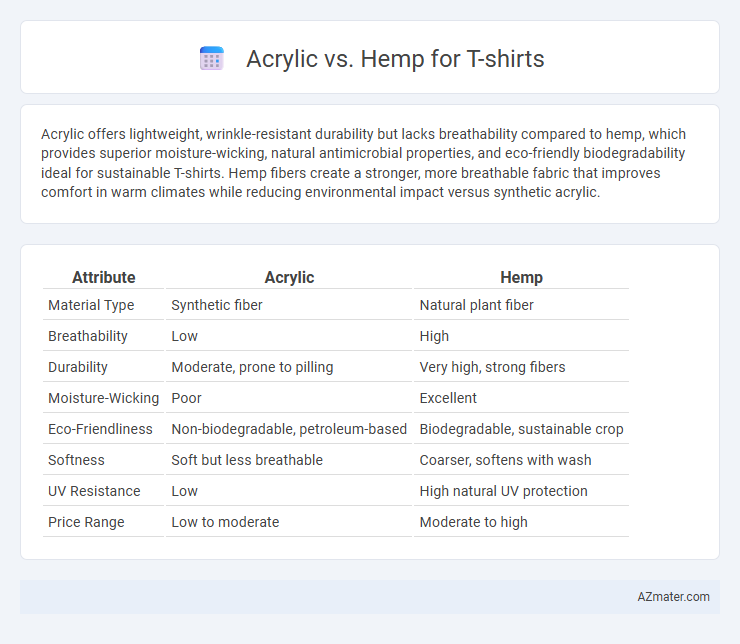Acrylic offers lightweight, wrinkle-resistant durability but lacks breathability compared to hemp, which provides superior moisture-wicking, natural antimicrobial properties, and eco-friendly biodegradability ideal for sustainable T-shirts. Hemp fibers create a stronger, more breathable fabric that improves comfort in warm climates while reducing environmental impact versus synthetic acrylic.
Table of Comparison
| Attribute | Acrylic | Hemp |
|---|---|---|
| Material Type | Synthetic fiber | Natural plant fiber |
| Breathability | Low | High |
| Durability | Moderate, prone to pilling | Very high, strong fibers |
| Moisture-Wicking | Poor | Excellent |
| Eco-Friendliness | Non-biodegradable, petroleum-based | Biodegradable, sustainable crop |
| Softness | Soft but less breathable | Coarser, softens with wash |
| UV Resistance | Low | High natural UV protection |
| Price Range | Low to moderate | Moderate to high |
Introduction: Acrylic vs Hemp for T-Shirts
Acrylic and hemp fibers differ significantly in sustainability, comfort, and durability for T-shirts. Hemp offers exceptional breathability, moisture-wicking properties, and natural antibacterial benefits, making it an eco-friendly choice. Acrylic, a synthetic fiber, provides vibrant color retention and affordability but lacks the environmental advantages and breathability of hemp.
Material Overview: What is Acrylic?
Acrylic is a synthetic fiber derived from polyacrylonitrile, known for its wool-like feel, durability, and resistance to wrinkles and fading. This lightweight material is hydrophobic, meaning it repels moisture and dries quickly, making it suitable for activewear and casual T-shirts. Unlike natural fibers such as hemp, acrylic offers consistent color retention and elasticity but lacks the breathability and environmental benefits of plant-based fabrics.
Material Overview: What is Hemp?
Hemp is a natural fiber derived from the stalks of the Cannabis sativa plant, known for its durability, breathability, and eco-friendly properties. Unlike synthetic fibers such as acrylic, hemp is biodegradable and requires fewer pesticides and water to cultivate, making it a sustainable choice for T-shirt fabrics. Its coarse texture softens with washing, providing a comfortable, moisture-wicking material ideal for everyday wear.
Comfort and Feel: Comparing Acrylic and Hemp
Hemp fabric offers superior breathability and moisture-wicking properties, making it exceptionally comfortable for T-shirts in warm weather. Acrylic, while softer and lightweight, tends to retain heat and moisture, which can result in a less breathable and sometimes clingy feel. Hemp's natural fibers provide a coarse texture that softens with wear, whereas acrylic maintains a consistently smooth but synthetic feel.
Breathability and Moisture Control
Hemp T-shirts excel in breathability and moisture control due to their naturally porous fibers, which allow airflow and wick sweat away from the skin effectively. Acrylic fabric, a synthetic material, generally lacks moisture-wicking properties, often trapping heat and moisture, leading to discomfort during prolonged wear. Choosing hemp over acrylic enhances comfort in hot or humid conditions by maintaining better airflow and faster drying times.
Durability and Longevity
Acrylic T-shirts offer moderate durability, maintaining shape and color after multiple washes but tend to pill over time. Hemp fabric is exceptionally strong, naturally resistant to wear and tear, and becomes softer with use without losing its structural integrity. Choosing hemp for a T-shirt ensures longer-lasting wear and sustained fabric performance compared to acrylic alternatives.
Environmental Impact and Sustainability
Hemp T-shirts offer a sustainable alternative to acrylic by being biodegradable and requiring significantly less water and pesticides during cultivation, which reduces environmental pollution. Acrylic fibers, derived from non-renewable petroleum, contribute to microplastic pollution and have a higher carbon footprint due to energy-intensive manufacturing processes. Choosing hemp over acrylic supports eco-friendly fashion by promoting renewable resources and minimizing waste in the textile industry.
Care, Maintenance, and Washing
Acrylic T-shirts require low-maintenance care, typically washed in cold water on a gentle cycle to prevent pilling and retain shape, while avoiding high heat drying to reduce fiber damage. Hemp T-shirts offer durable and breathable fabric but need careful washing in cold or warm water with mild detergent to maintain fiber integrity and avoid shrinkage; air drying is recommended to preserve texture and longevity. Proper care for both fabrics enhances their lifespan, with hemp benefiting from less frequent washing due to its natural odor resistance, contrasting acrylic's quicker drying properties.
Price Comparison: Acrylic vs Hemp T-Shirts
Acrylic T-shirts are generally more affordable than hemp T-shirts due to lower production costs and widespread availability of synthetic fibers. Hemp T-shirts command a higher price because of their eco-friendly cultivation, durability, and natural antimicrobial properties. Consumers seeking budget-friendly options often opt for acrylic, while those prioritizing sustainability may invest more in hemp apparel.
Choosing the Best Fabric for Your Needs
Acrylic fabric offers vibrant colors, softness, and affordability, making it ideal for casual, budget-friendly T-shirts. Hemp fabric stands out for its durability, breathability, and eco-friendly properties, perfect for those seeking sustainable and long-lasting wear. Consider factors like environmental impact, fabric longevity, and comfort preferences to choose the best material tailored to your lifestyle and values.

Infographic: Acrylic vs Hemp for T-shirt
 azmater.com
azmater.com